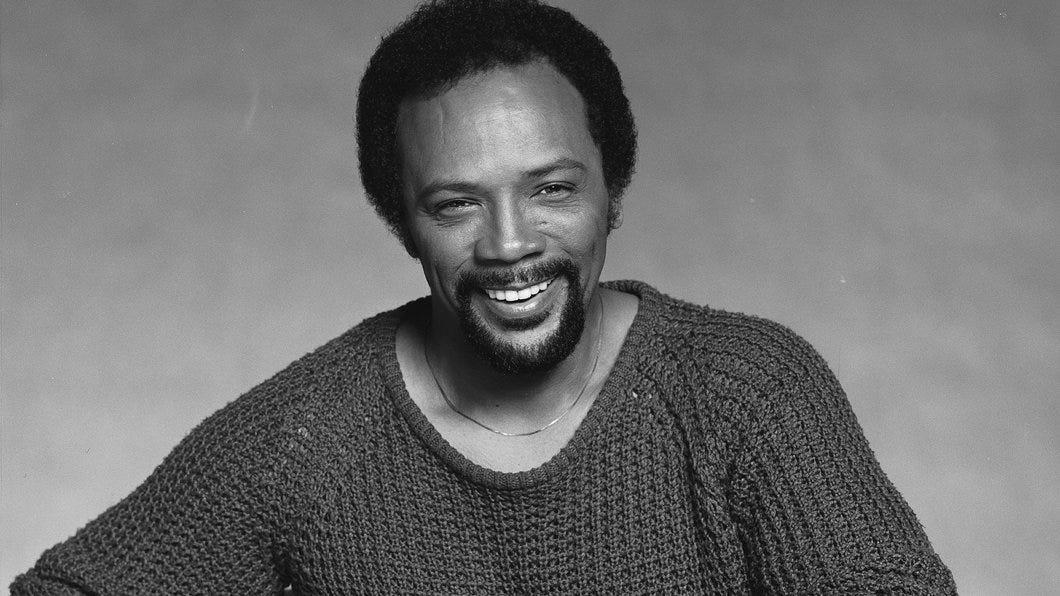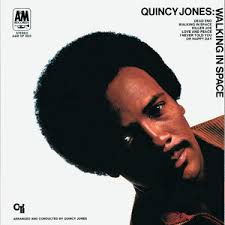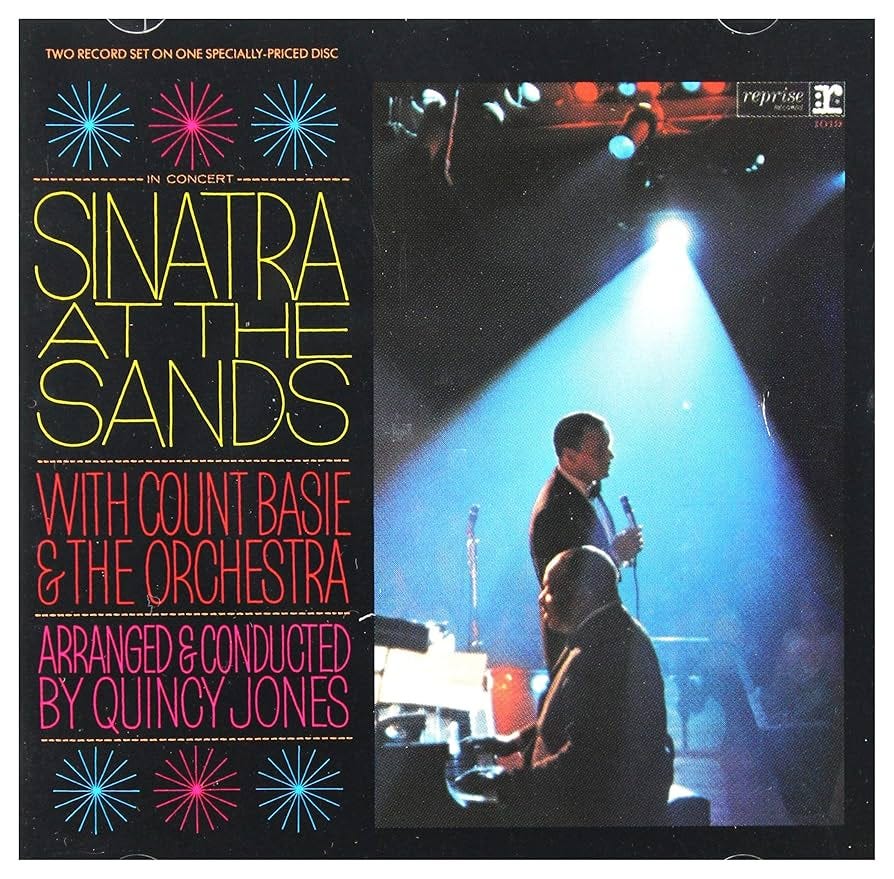Quincy Jones's South African music dream
How the late music icon took an early step into audio streaming with QRadio
I have looked hard but in all the tributes to the late Quincy Jones that I have read since he died on November 3rd, there is no mention of the time he launched a website for South African music.
Of course, I say this half-jokingly because even those writers who attempted an extensive sweep of this music icon’s work could not have possibly included everything he achieved, especially within the short-form confines of most digital publications.
That’s not just because he was 91 when he died in his home in Bel-Air and so had a remarkable seven decade music career that began in 1953 when the then 20-year-old, trumpet-playing Jones began touring with jazz bandleader Lionel Hampton. The impossibility of capturing Jones’s achievements also lies in the expansiveness of his musical talents - he was a musician, an arranger, a band leader, a composer, a collaborator and a producer - along with the sheer scope of his musical curiosity and appetite. The latter still remains out of the ordinary - spanning pop (across vastly different eras, from Frank Sinatra to Donna Summer and, most famously, Michael Jackson) as well as R&B and hip-hop, which Jones said he fell in love with in the seventies because it reminded him of the Bebop he’d worked in decades before. Other musical areas traversed by Jones were Bossa Nova in the 1960s, and jazz. His extensive work in the latter included winning a Best Large Jazz Ensemble Grammy in 1968 for Walking in Space (featuring a great photo of Jones taken by American photographer Pete Turner and tilted sideways on the cover, as if to underscore his unusual, out-of-this-world talent) and also leading an ensemble at the 1991 Montreux Jazz Festival, a collaboration with Miles Davis that was captured on the album, Miles & Quincy Live at Montreux that won Davis his seventh Grammy and was the last one recorded by the trumpeter before his death a handful of months later.
Jones also had an enduring appetite for working on movie soundtracks and television themes and it was because of this that I landed up working for him in 1998.
How? Well, in that year I became part of the South African team charged with running QRadio - the latest in Jones’s media initiatives which, back then, included a record label, a broadcasting company, and Vibe magazine.
When I say team, what I really mean is South African music industry stalwart, Julian von Plato (co-founder of DiscovrTV) and myself because we were the two people regularly sourcing and feeding music and writing - artist biographies, short reviews - into Jones’s website that had been launched as a way to “introduce global audiences to musicians rarely heard outside their countries of origin”, as a February 1998 article put it. “The site will begin by presenting the new sounds boiling out of South Africa - a cultural renaissance energized by the end of apartheid and the return of exiled musicians to their homeland,” the article added.
The radio part of QRadio was a “RealAudio Player” that allowed users to stream audio over the internet for the first time - in this case, music feeds from the South African Broadcasting Corporation’s suite of radio stations. In the post apartheid-era, these stations were exploding with new sounds (kwaito and South African-brewed hip hop among them) and were, at the time, the primary way that most South Africans consumed music. In fact, the first feed that QRadio received was from IsiZulu station Ukhozi FM, which - 26 years later - remains Africa's biggest radio station, and the world's second biggest radio station with 7.9 million listeners.
Julian and I had come to be part of QRadio through Caiphus Semenya who had been appointed executive producer of the website by Jones and QRadio president, Don Brown. During apartheid - in 1964 - the South African composer and musician had been forced into exile in the US with his wife, singer Letta Mbulu, getting his footing in a new country singing backup for Miriam Makeba and eventually doing arranging work for Harry Belafonte and others. Unsurprisingly Semenya and Mbulu connected with Jones and they both worked with him on his 1977 album, Roots: The Saga of an American Family, featuring music from - and inspired by - the hit television mini-series of the same name. Mbulu sang on a trio of tracks - “Mama Aifambeni”, “Behold The Only Thing Greater Than Yourself (Birth)” and “Oluwa (Many Rains Ago)” - with Semenya contributing vocals and songwriting too. A decade later, Jones called on Semenya to work on the Swahili chant arrangement for “Liberian Girl”, a song off Bad, one of a trio of albums that Jones produced for Michael Jackson (the others being 1979’s Off the Wall and 1982’s Thriller). Semenya also provided backing vocals on the title track of Jones’s Grammy Award winning album Back on the Block (1989).
More than 20 years after they first worked together, with Semenya and Mbulu now returned to South Africa from exile, Jones asked Semenya to play a key role in the launch of QRadio. It seems quaint to read about it now, but QRadio was billed as Jones’s next step into making music accessible, following his breakthrough 1996 multimedia project - a CD-ROM (when last did you think about those!) that contained a history of African-American music making called Q's Juke Joint. Long before streaming brought music from any place on earth into the ears of anyone on earth with an internet connection, QRadio was seen by Jones as a way of doing just that. "Quincy is a guy who has experimented with a lot of different media to create fusions," Brown was quoted as saying. "We're hoping this will not just be a channel for distributing music from one place to another ... but a way to change listening patterns, a place where styles will mix, and the world of music will open up.”
As might be expected for a website that was a decade ahead of even Spotify’s opening days, QRadio didn’t last more than a handful of years. Jules and I had lots of fun ‘though, and, a few years later, repeated our working relationship when he brought me in to work on the content for another ambitious content platform that he was running, EntertainmentAfrica.com. And Jones never gave up on his mission to bring music directly to the people, launching the video streaming network Qwest TV in 2017, dedicated to “black music and global sounds”.
“Qwest TV, a platform that provides viewers with a new and approachable way to discover the music that they were never formally introduced to." Quincy Jones.
Interviewed after Jones’s death, Semenya didn’t mention our shared foray into a type of early music streaming but was unstinting in his praise of Jones.
“He was very instrumental in some of our advancement in music, in understanding music,” the composer and musician told a television interviewer. “He was such a meticulous arranger, meticulous composer and one of the greatest - if not the greatest - producer in the world. He really did leave a great legacy with us, with me, with my wife and of course with many other people that he worked with. He was one-of-a-kind. There will never be another one like him.”
I leave you with this, dear reader.
We once met Jones at a late afternoon gathering at the American consulate’s home in Johannesburg. My memory is fuzzy but I think he was in town to see Nelson Mandela, a longtime friend of Jones’ and for whom he wrote the the song “Madiba” for the Nobel Peace Prize winner’s 80th birthday (Anant Singh, the South African producer of Mandela: A Long Walk to Freedom, shared on social media after Jones’s death that the original music sheet and lyrics still hang at Sanctuary Mandela in Johannesburg). My partner and I recall a warm conversation, during which we were joined by Lance Stehr, founder of longstanding and influential independent music label, Ghetto Ruff and kwaito star, Zola 7.
And this: if you’re looking for a place to start in Jones’s vast catalogue of work, try “You Make Me Feel So Young” off Sinatra At The Sands. In the week following Jones’s death it was the choice of my good friend Mark Rosin for his The Friday Song WhatsApp group where he shares excellently - and expertly - written capsule reviews of songs he loves for an ever expanding group of followers.
Of the Sinatra song, conducted and arranged by Jones, he says,
“Do me a favour and don’t just listen to Frank because you know the song or don’t listen because you’re not a Frankie fan. For today, take a listen to this version by this band. You will float with the brass and sway with the horn arrangements. Listen how Quincy conducts the dynamics, from the feather light touches between and behind phrases, to the big band bombs at key moments. Listen to the clipped upper register double bass notes, snare drum rim shot, (Count) Basie’s single strikes and a great big whack of swing, with a driving coda to close. This is one of the great live albums of all time and testimony in large part to the greatness that was Quincy Jones.”
And finally this: it’s been some time since my last Substack post. The reason, dear readers, has everything to do with this recent article I wrote for South African publication, Daily Maverick, that details my treatment for breast cancer. Like many of you, I suspect, 2025 can’t come fast enough and I thank you all for staying with me in this erratic writing year.







Thanks for your great piece on Q Di and such a unique angle! And thanks too for the shout out for my Friday Song group!
Learning so much from you, mama! What an incredible man and an equally incredible piece to represent him